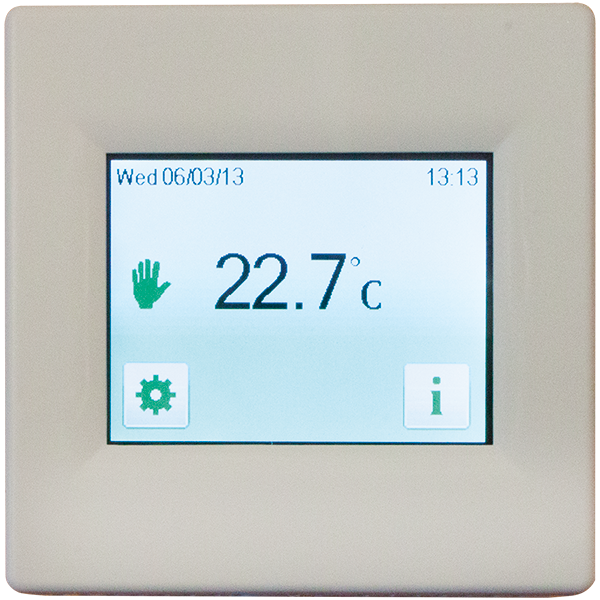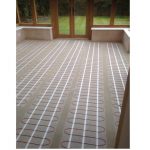
M Series underfloor heating mats are backed with a lifetime warranty
Underfloor Heating Tiles
Underfloor heating in a room with a tiled floor can provide an economic means of heating a room whilst also providing a luxurious warm floor. The heating equipment to meet both these objectives is usually exactly the same although there may be a difference in the way the thermostat is set up and we will look at that in the control section below.
Both heating systems supplied by BN Thermic use a high-quality heating cable and both should be installed immediately below the tiles either in the tile adhesive or in a latex based self-levelling compound.
Heating Mats
The most widely used method of underfloor heating for a tiled floor is the heating mat. BN Thermic heating mats consist of a twin-core heating cable assembled onto a 500mm wide fiberglass web. The cable is pre-terminated with a 3m power lead and the web is fitted with a continuous run of double-sided tape.
Heating mats can be installed in any room including bathrooms and wet rooms.
Heating mats are best suited to more regular shaped rooms. The 500mm wide fiberglass web maintains optimum cable spacing and ensures the quickest possible installation time.

BN Thermic can assist selecting the right mat your underfloor heating project
Selecting a Suitable Mat
BN Thermic offers two ranges of heating mats: standard output (150W/m²) and high output (200W/m²). High output mats are generally used in high heat loss rooms such as conservatories or when the fastest possible warm up time is required. For most rooms, standard output mats are sufficient.
When selecting mats for a specific room, the objective is to cover a much of the free floor area as possible. Mats should not be installed under fixtures such as kitchen cabinets and shower trays. As a rule of thumb, we suggest selecting a mat with an area approximately 10% smaller than the free floor area.
BN Thermic supplies mats covering areas up to 18m². However, for larger rooms, it is common practice for two or more mats to be used. Generally, the mats are connected in parallel and controlled from a single thermostat.
Heating Cables
Heating cables are recommended used for smaller and irregularly shaped rooms. The cable or ‘loose wire’ as it is sometimes called, is supplied on a drum and is pre-terminated with a 3m power lead. Each cable is supplied with sufficient high adhesive tape to hold the cable to the sub-floor.
BN Thermic heating cables can be installed in any room including bathrooms and wet rooms.
The cable should be arranged in a series of evenly spaced loops covering as mush of the free floor area as possible.

BN Thermi loose cable systems are covered with a lifetime warranty
Selecting a Heating Cable
First calculate the free floor area (total floor area minus any permanent fixtures such as cabinets and shower trays). Then, simply select the cable with a coverage range which includes the calculated free floor area.
For larger rooms, it is common practice for two or more cables to be used. Generally, the cables are connected in parallel and controlled from a single thermostat.
The Importance of Insulation
The best way to reduce the running costs of an underfloor heating installation is to limit downward heat loss by means of insulation. Many modern homes have well-insulated floors. However, in older properties insulation should be installed before a mat or cable is fitted.
BN Thermic supplies two thicknesses of insulation boards 6mm and 10mmm. Whenever possible, we would suggest installing the 10mm thick boards which are simply stuck to the sub-floor using tile adhesive.

Insulation boards greatly improve the economy of an underfloor heating system. BN Thermic always carry large stocks

The T16C color touch screen range of controllers is available in three finishes – white, silver and black
Thermostatic Control
Each room will require its own programmable thermostat. BN Thermic offer a range of suitable thermostats to meet different aesthetic requirements, tastes and budgets. However, all BN Thermic programmable thermostats share the same key features.
When using underfloor heating as a sole source of heat, primary temperature control is by means of the thermostat’s built-in temperature sensor. The thermostat’s floor probe, which is installed at the same level as the heating mat or cable, will then act as a safeguard ensuring that the floor does not become uncomfortably warm.
If the main aim of the system is to provide a warm floor, and especially when other methods of heating are in use, the thermostat’s built-in air sensor should be by passed and temperature control should only be by means of the floor probe. Adjustment from ‘air and floor’ to ‘floor only’ is simple to achieve and detailed instructions are provided with the thermostat.
In some installations, notably bathrooms, it is common for the thermostat to be located outside the room being heated. In these circumstances ‘floor only’ control is generally used.

The new B16C controller offers full 7 day control at a very competitive price
FAQs
-
A tiled floor with underfloor heating will not feel anything like as hot as conventional radiator. This is because the required heating effect is spread over the entire floor area. We generally suggest using a thermostat’s floor probe is used to limit floor temperatures to around 28°C maximum and, depending where we are on the heating cycle, the floor will often be somewhat cooler than that.






